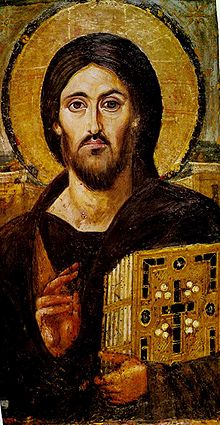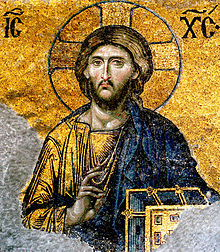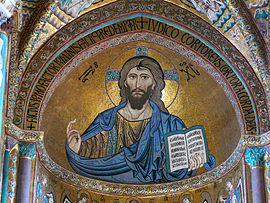- Christ Pantocrator
-
For other uses, see Pantokrator (disambiguation).
In Christian iconography, Christ Pantokrator refers to a specific depiction of Christ. Pantocrator or Pantokrator (from the Greek Παντοκράτωρ) is a translation of one of many Names of God in Judaism. When the Hebrew Bible was translated into Greek as the Septuagint, Pantokrator was used both for YHWH Tzevaot "Lord of Hosts" and for El Shaddai "God Almighty".
Contents
Meaning
The most common translation of Pantocrator is "Almighty" or "All-powerful". In this understanding, Pantokrator is a compound word formed from the Greek words for "all" and the noun "strength" (κρατος). This is often understood in terms of potential power; i.e., ability to do anything, omnipotence.
Another, more literal translation is "Ruler of All" or, less literally, "Sustainer of the World". In this understanding, Pantokrator is a compound word formed from the Greek for "all" and the verb meaning "To accomplish something" or "to sustain something" (κρατεω). This translation speaks more to God's actual power; i.e., God does everything (as opposed to God can do everything).
The Pantokrator, largely an Eastern Orthodox or Eastern Catholic theological conception is less common by that name in Western (Roman) Catholicism and largely unknown to most Protestants. In the West the equivalent image in art is known as Christ in Majesty, which developed a rather different iconography.
Uses in the New Testament
 The oldest known icon of Christ Pantocrator, encaustic on panel (Saint Catherine's Monastery, Mount Sinai). The two different facial expressions on either side emphasize Christ's dual nature as fully God and fully human.[1][2]
The oldest known icon of Christ Pantocrator, encaustic on panel (Saint Catherine's Monastery, Mount Sinai). The two different facial expressions on either side emphasize Christ's dual nature as fully God and fully human.[1][2]
In the New Testament, Pantokrator is used once by Saint Paul (2 Cor 6:18). Aside from that one occurrence, the author of the Book of Revelation is the only New Testament author to use the word Pantokrator. The author of Revelation uses the word nine times,[3] and while the references to God and Christ in Revelation are at times interchangeable, Pantokrator appears to be reserved for God alone.
Later development
The primary transference of the title "Pantokrator" to refer to Christ rather than the Creator was a result of the Christological shift that occurred during the fourth century, reflected through iconography; Christ Pantocrator has come to suggest Christ as a mild but stern, all-powerful judge of humanity.
The icon of Christ Pantokrator is one of the most widely used religious images of Orthodox Christianity. Generally speaking, in Byzantine church art and architecture, an iconic mosaic or fresco of Christ Pantokrator occupies the space in the central dome of the church, in the half-dome of the apse or on the nave vault. Some scholars (Latourette 1975: 572) consider the Pantocrator a Christian adaptation of images of Zeus, such as the great statue of Zeus enthroned at Olympia. The development of the earliest stages of the icon from Roman Imperial imagery is easier to trace.[4]
The icon, traditionally half-length when in a semi-dome,[5] which became adopted for panel icons also, depicts Christ fully frontal with a somewhat melancholy and stern aspect, with the right hand raised in blessing or, in the early encaustic panel at St. Catherine's, the conventional rhetorical gesture that represents teaching. The left hand holds a closed book with a richly decorated cover featuring the Cross, representing the Gospels. An icon where Christ has an open book is called "Christ the Teacher", a variant of the Pantocrator. Christ is bearded, his brown hair centrally parted, and his head is surrounded by a halo. The icon is usually shown against a gold background comparable to the gilded grounds of mosaic depictions of the Christian emperors.
In some variants, on each side of the halo are Greek letters: IC and XC. Christ's fingers are depicted in a pose that represents the letters IC, X and C, thereby making the Christogram ICXC (for "Jesus Christ"). The IC represents the Greek characters Iota (Ι) and Sigma (Σ, ς) - the first and last letters of Jesus (Ιησους). The letters XC represent Chi (Χ) and Sigma (ς) - the first and last letters of Christ (Χριστος).
The typical Western Christ in Majesty is a full-length icon that in the early Middle Ages usually showed Christ in a mandorla or other geometric frame, surrounded by the Four Evangelists or their symbols.
Iconography
The iconic image of Christ Pantocrator was one of the first images of Christ developed in the Early Christian Church and remains a central icon of the Eastern Orthodox Church. In the half-length image, Christ holds the New Testament in his left hand and makes the gesture of teaching or of blessing with his right.
The oldest known surviving example of the icon of Christ Pantocrator was painted in encaustic on panel in the sixth or seventh century, and survived the period of destruction of images during the Iconoclastic disputes that twice racked the Eastern church, 726 to 787 and 814 to 842, by being preserved in the remote desert of the Sinai, in Saint Catherine's Monastery.[6] The gessoed panel, finely painted using a wax medium on a wooden panel, had been coarsely overpainted around the face and hands at some time around the thirteenth century. It was only when the overpainting was cleaned in 1962 that the ancient image was revealed to be a very high quality icon, probably produced in Constantinople.[citation needed]
See also
- Salvator Mundi
- Christ the Redeemer
- Images of Jesus
- Transfiguration of Jesus
Notes
- ^ God's human face: the Christ-icon by Christoph Schoenborn 1994 ISBN 0898705142 page 154
- ^ Sinai and the Monastery of St. Catherine by John Galey 1986 ISBN 9774241185 page 92
- ^ Pantocrator appears in Revelation 1:8, 4:8, 11:17, 15:3, 16:7, 16:14, 19:6, 19:15, and 21:22.
- ^ Eduard Syndicus; Early Christian Art; p. 96-99; Burns & Oates, London, 1962. Hall pp. 78-80; James Hall, A History of Ideas and Images in Italian Art, pp. 91-97, 1983, John Murray, London, ISBN 0719539714
- ^ Otherwise the size of the figure would have to be greatly reduced to avoid the head appearing at the flattening top of the semi-dome.
- ^ Manolis Chatzidakis and Gerry Walters "An Encaustic Icon of Christ at Sinai" The Art Bulletin 49.3 (September 1967) pp. 197-208.
References
- Latourette, Kenneth Scott, 1975. A History of Christianity, Volume 1, "Beginnings to 1500". Revised edition. (San Francisco: Harper Collins)
- Christopher Schonborn, Lothar Kraugh (tr.) 1994. God's Human Face: The Christ Icon. Originally published as Icôn du Christ: Fondements théologiques élaborés entre le Ie et IIe Conciles de Nicée (Fribourg) 1976
Further reading
- Chatzidakis, Manolis, (Gerry Walters, tr.) "An Encaustic Icon of Christ at Sinai" The Art Bulletin 49.3 (September 1967), pp. 197–208.
External links
- Galavaris, George (Jan 1, 1981). The Icon in the Life of the Church, 11. Google Print. ISBN 90-04-06402-8 (accessed November 3, 2005). Also available in print from Brill Academic Publishers.
- The Christ Pantocrator Icon at St. Catherine's Monastery in the Sinai
Yahwistic titles of Jesus in Greek Yahwistic titles of Jesus in GreekCategories:- Jesus
- Iconography of Jesus
- Eastern Orthodox icons
- Christian terms
Wikimedia Foundation. 2010.





